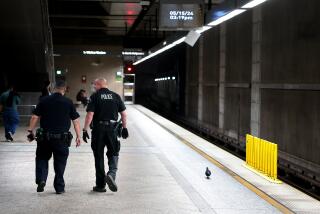Stuck in Traffic? Listen Carefully to Decipher Jam Frequency
- Share via
As you sit sandwiched between the frantic cellular phone dialer and the driver applying eyeliner, you decide to tune in to a radio traffic report to find out what’s put the brakes on your commute. But you hear no mention of the backup you’re in. Could it be that the traffic reporters in helicopters above can’t see the gridlock?
Not likely. From the sky, they can see the roads below for miles, sometimes well enough to read the freeway signs. And what they don’t see, their ground crew--producers and anchors--are monitoring via numerous computers, freeway cameras, two-way radios and tips from commuters calling from the very messes they are reporting. So why haven’t you heard anything of your predicament?
Well, maybe your timing was off.
“I think because traffic reports [happen sporadically], people often will call us” to complain that the freeway they’re stuck on wasn’t mentioned, said Tim Curtin, Los Angeles regional president and general manager of Shadow Broadcasting Services.
“Los Angeles is quite a large metropolitan area,” especially when reporting on it in 30- to 60-second increments, said Richard Marks, Shadow’s chief operating officer.
Because most traffic reports last a minute or less, depending on the station, there’s only so much they can touch on to give listeners enough information about any one incident. Plus, if it’s a heavy traffic news day, anchors and reporters may choose to focus on incidents they hadn’t covered in an earlier report.
“The priority is usually the bigger stuff first,” said Robin Banks, director of operations at Metro Traffic and the in-house anchor for KZLA-FM (93.9).
The freeways are always going to be crowded during rush hour, and in L.A., drive times are almost all the time, Marks said. Between 6 and 9 a.m. and again from 3 to 7 p.m., you’re sharing Los Angeles metro-area roadways with nearly 3 million drivers, roughly equal to the population of Dallas, according to statistics gathered by the state Department of Transportation and the Department of Motor Vehicles in 1997.
*
With that in mind, traffic reporters are going to try to point out the unusual. So, although I always tune in to learn what’s backing traffic up on the Glendale Freeway (2) at the Golden State (5), I’m more likely to hear a report if the interchange is clear, since a backup there is considered normal.
The more heavily traveled freeways--the San Diego (405), Santa Ana/Golden State (5), Hollywood/Ventura (101), Santa Monica/San Bernardino (10), Pomona (60), Riverside/Artesia/Gardena (91)--are likely to get more coverage. In addition to discussing specific stretches of road, most reporters give information about interchanges, Marks said.
In Southern California, Shadow Traffic and Metro Traffic dominate. Shadow serves stations such as KFWB-AM, KNX-AM, KHWY-FM and KLON-FM, and Metro’s reports can be heard on stations such as KBIG-FM, KGGI-FM, KEZN-FM and KLAX-FM and seen weekday mornings on KNBC-TV Channel 4, KCBS-TV Channel 2 and KTTV-TV Channel 11. (Shadow’s parent, Culver City-based Westwood One, announced June 1 that it plans to buy Metro’s parent, Houston-based Metro Networks, for $900 million, although both say operations won’t change.)
Their reports usually include the location of the problem (freeway, city and nearest offramps), how many lanes are affected and how long it could tie up traffic. In addition to covering the what, where, when, why and how long, some reports offer alternate routes or freeway comparisons. For instance, if airborne traffic reporters are near the San Bernardino and Pomona freeways, “they will check to see which is more congested,” said Rhonda Kramer, an anchor who has been with Shadow since 1979.
In addition to “airbornes” (helicopters and planes), most of the information comes from computers that supply information on traffic flow and traffic incidents.
By using sensors embedded in the roadways, Caltrans collects and transmits data on how fast vehicles are moving on area freeways. Producers at the traffic services can view this information by computer to help compile their reports. (Drivers can too; see accompanying box.)
The traffic services also receive reports directly from law enforcement officials as they are entered on something called computer-aided dispatch, or CAD.
Many listeners double as dedicated reporters: They call in incidents, occasionally giving the traffic organizations a heads-up or additional details, although neither service reports anything without confirmation.
“They feel like they’re a part of it,” Kramer said of such callers.
*
Staffers at both Shadow Traffic and Metro Traffic say that to make best use of their reports, drivers need to be active listeners. That is, keep an ear open for the area nearest your snarl, because it’s easy to zone out while waiting for the report to air.
Although this is almost a no-brainer, it’s also important to know where you are going, said Scott Forrest, assistant news bureau chief for Metro Traffic, who was an airborne reporter for four years. In other words, have a few alternatives in the event you can change your path before you come face to face with a sea of brake lights.
Along the same lines, it’s important to know where you are. There’s always the temptation to drive on autopilot or get distracted by phones or music. Besides being unsafe, it’s not really time-efficient.
(BEGIN TEXT OF INFOBOX / INFOGRAPHIC)
Real-Time Traffic
* Check out your route before you hit the road. Real-time traffic updates are available on The Times’ Web site at https://www.latimes.com/traffic.
*
Michelle Maltais can be reached at michelle.maltais@latimes.com.
More to Read
Sign up for Essential California
The most important California stories and recommendations in your inbox every morning.
You may occasionally receive promotional content from the Los Angeles Times.













